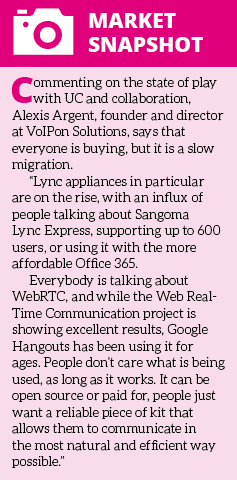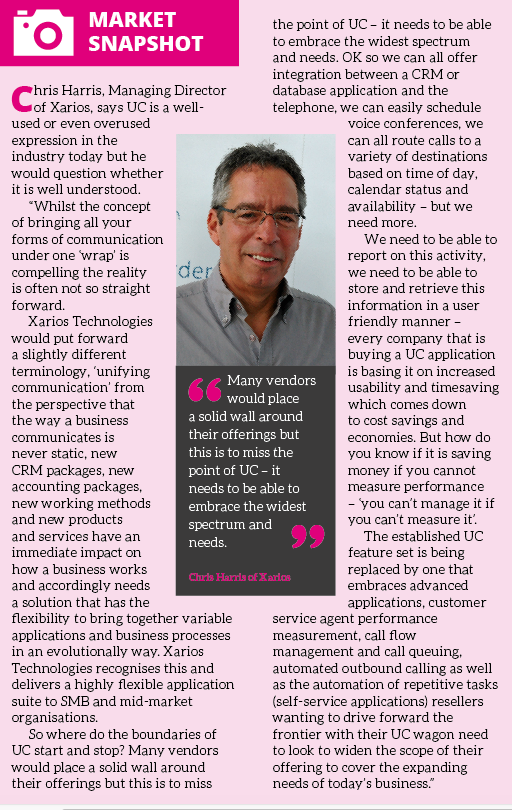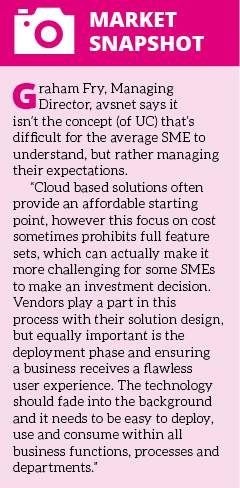
Selling unified communications to the SME is not easy. More often than not you have to sell the concept, the benefits and the applications to someone who generally has a day job away from the UC action.
 The potential for Unified Communications is huge but does the SME understand what it is all about and where they can gain a competitive advantage? We ask vendors and resellers some key questions to find out the answers.
The potential for Unified Communications is huge but does the SME understand what it is all about and where they can gain a competitive advantage? We ask vendors and resellers some key questions to find out the answers.
Is the concept of unified communications very difficult for an SME to understand? Why is that and what can we do about it?
Gavin Sweet, Director, Skyrack Telecom says that Unified Communications (UC) is easy to describe superficially.
“It’s simply the real-time integration of communication services – but difficult to pin down in the detail. It can potentially cover a huge breadth of services – voice, mobile, SMS, fax, video, IM, presence, conferencing, email, desktop apps etc. – all of which can be used in different modes, from different devices and different contexts.
So for the average SME, it is kind of bewildering to start considering a UC solution – you’re looking at the fruit bowl wondering which are apples and which are pears, and which flavour you prefer, let alone how to compare them!
In fact, what we find at Skyrack is that most customers don’t come looking for UC, they come looking for their own idea of some kind of service integration that brings together X and Y, maybe with Z. And we’re finding that these customers are more and more engaged and more and more tech savvy. Many have already built up their own IT and comms services across suppliers, and some have intelligence about what is available in the market, or perhaps ‘in the cloud’.
Kevin Scott-Cowell, Chief Executive Officer at 8x8 Solutions would seem to agree when he says the concept of UC isn’t difficult but the way it’s described can be daunting.
“Many SMEs don’t have a member of staff dedicated to IT or telecoms so you’ll often be dealing with the office manager or even the CEO directly. They can be put off when confronted with technical language, so UC providers need to drop the jargon and speak in terms SMEs do understand. What we find they recognise is the real world impact of software, like being able to hold seamless video conferences from various different offices, or simply the greater ability to communicate with their employees and customers.”
Mark Russell, Director of Operations for UK and Ireland at UC provider Swyx hits the nail on the head; “If you ask ten different SMEs for their definition of UC you are likely to get ten different answers.
Whilst the term is now better known than it was five years ago, it’s still an umbrella buzzword that is open to interpretation. The reality is that most SMEs are now already using part of the numerous features that UC delivers whether it’s IM, video or presence, but are sometimes relying on a plethora of standalone products to achieve each function. The role of the reseller is to avoid bamboozling end-users with marketing speak and to simply listen and understand the individual customers so they can then build a bespoke solution that unifies not only business communications but also business processes to deliver maximum benefit.”
 Mike Wilkinson, VP for Product Marketing at BroadSoft adds that while there is evidently a buzz around hosted unified communications within the communications industry and IT functions, the typical SME business owner may only understand communication challenges within their current environment.
Mike Wilkinson, VP for Product Marketing at BroadSoft adds that while there is evidently a buzz around hosted unified communications within the communications industry and IT functions, the typical SME business owner may only understand communication challenges within their current environment.
“For many SMEs, the key decision maker is the business owner, and their focus is not on communications infrastructure but rather on ‘How can I solve this immediate challenge?’ Business owners are often seeking a service which improves the bottom line – boosting productivity and increasing employee efficiency as well as enabling communication both internally and externally.
To solve this, communication providers need to raise awareness around available solutions and benefits to business challenges whilst also focusing on the research stage of the sales pipeline. Communication providers can benefit from simplifying messaging around direct benefits to personalised challenges. So rather than pushing out endless reams of statistics, communications providers should focus on case studies of companies in similar industries who encountered similar problems to the buyer. In short, providers should make it easy to understand the benefits by explaining it from the buyer’s perspective.
Unified Communications can be difficult to understand for a simple reason - everyone has their own interpretation of what UC actually is!
Modern UC is about selling a service rather than a product. Customers shouldn’t have to get bogged down with technical specifications or understanding complex solutions. They just need to know how the proposed UC solution on a day-to-day basis helps meet their business critical communications requirement, and delivers better productivity, ease of use, and value.”
Should vendors produce an SME Edition of unified communications applications? Would it increase sales and help everyone gain a better understanding? Or is this how resellers can differentiate in the market?
Indi Sall, Technical Director at NG Bailey’s IT Services believes that SMEs represent an un-tapped market unified communications, and the sector would certainly benefit from a ‘UC-lite’ offering.
“Until such a platform becomes available, there are strong opportunities for resellers to differentiate themselves through managed services, mopping up the integration and maintenance work that SMEs are unable to do themselves. A simplified SME focused unified communications solution would definitely increase sales for vendors in the lower end SME market.”
Cloud based UC solutions offer a streamlined and cost effective approach for smaller resellers especially.
Jon Nowell, Head of Product Management at TalkTalk Business makes a very valid point when he says the problems lie in demonstrating to SMEs that UC is applicable to their situation.
“By its very nature UC is suitable for businesses of all sizes, the challenge is to frame it as a solution to SMEs business challenges. With new communication technologies constantly coming to market small businesses communications estate is growing and ultimately becoming more challenging to manage.
 With SMEs accounting for 99.3 per cent of all private sector businesses in the UK, and employing 15.2 million people, the market offers a fantastic opportunity for the channel. The key job for the channel though is one of education. It is important we communicate to SMEs the clear business benefits of UC, to ensure they perceive unifying systems as a strategic priority for their business.
With SMEs accounting for 99.3 per cent of all private sector businesses in the UK, and employing 15.2 million people, the market offers a fantastic opportunity for the channel. The key job for the channel though is one of education. It is important we communicate to SMEs the clear business benefits of UC, to ensure they perceive unifying systems as a strategic priority for their business.
UC offers scalable, future-proof technology, which is especially important for SMEs looking for rapid expansion. It is important to explain the concept to SMEs in terms of growth, collaboration and flexibility. Recent research from TalkTalk Business found that business growth is the top priority for 22% of SMEs in 2015, giving SMEs the technology which allows for rapid expansion and saves them from problems further down the line will help to simplify the concept and contextualise it within their objectives for their business.”
Dave Joplin of Exponential-e looks at the building blocks for UC.
“Coming from a 100% hosted background, we are supplying the building blocks for our Channel Partners to build the SME focus solutions. So in this case it would be the Broadsoft platform with the UCC licensing. We also provide further building blocks in connectivity, handsets if need be and training that can be white-labelled where a partner can add further value around mobile devices and LAN management and maintenance to maximise the UC experience.”
Conversely Glynn Jones, VP EMEA Channels & Advanced Technology Group at Polycom does not think the approach is necessarily to produce an SME Edition of UC applications, because there’s still the issue of potentially investing in aspects of UC that don’t match the company’s requirements.
“Rather than an SME Edition, there needs to be an SME Approach, particularly for partners. One of the main reservations for SMEs is that they don’t have the capital to invest in a full UC setup or the stability to commit to purchasing hardware and infrastructure. So the approach needs to be tailored - SMEs need carefully selected solutions that provide them flexible and scalable UC solutions, specific to their business processes.
 Partners need to make hardware and software available as a service, to better fit the SME’s needs. However equally, vendors need to support this, by making these services available in a more scalable offering, which often means through cloud. Polycom has seen a growth of interest from SMEs following the launch of its Video as a Service offering in the UK. Polycom launched this with distributor Imago, to support its partners’ offering to SMEs, who are keen to progress from telephony based UC, to video collaboration.
Partners need to make hardware and software available as a service, to better fit the SME’s needs. However equally, vendors need to support this, by making these services available in a more scalable offering, which often means through cloud. Polycom has seen a growth of interest from SMEs following the launch of its Video as a Service offering in the UK. Polycom launched this with distributor Imago, to support its partners’ offering to SMEs, who are keen to progress from telephony based UC, to video collaboration.
Solutions as a service are ideal for SMEs, because essentially they provide an enterprise-grade solution irrespective of device, that can flex and scale with the fluctuations of an SME in workload and headcount. For example, a small retailer may need additional staff on customer services over the busy Christmas period, so solutions as a service give the retailer the flexibility to increase the number of seats on its hosted services, and then decrease these again when the Christmas rush is over.”
Ed Says
I remember UC from ‘back in the day’. The first app I saw was Unified Messaging from a firm in Reading called TopCall. Basically you got fax messages integrated with email messages in Outlook along with an invoice for the service that made your eyes water. Today you still get what you pay for but you get a lot more for your money and can, even as an SME or smaller, install a lot of the apps yourself. Lync? Only if you have your own resourceful IT department or take a hosted service. Show me otherwise.
